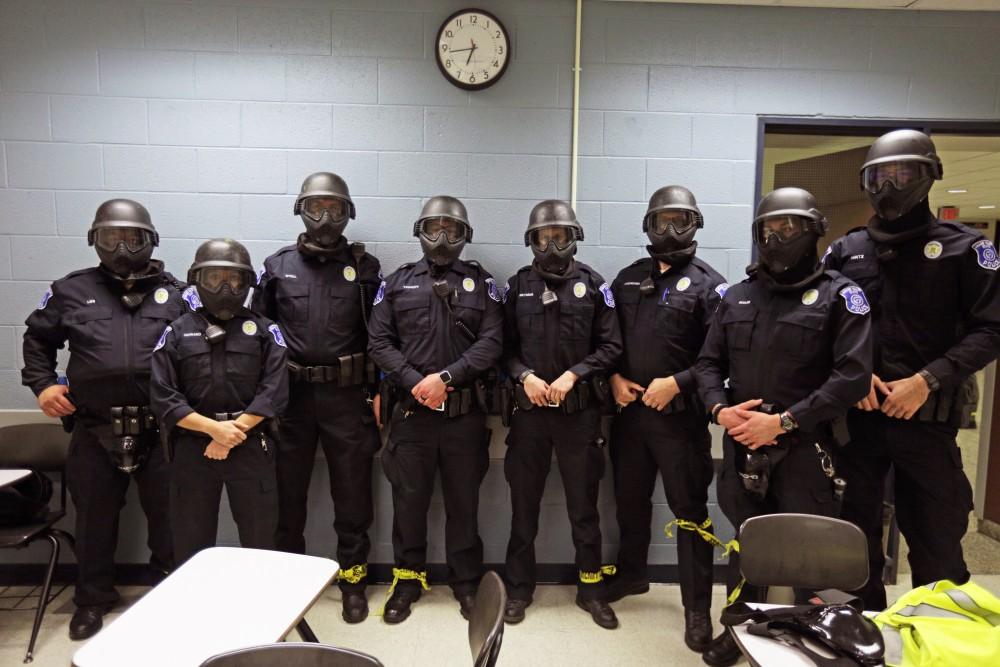GVPD holds active-shooter-response training in Mackinac Hall

GVL / Emily Frye Grand Valley Police Department work alongside other safety departments in the surrounding area to train in the case of an active shooter on Sunday December 17, 2017.
Jan 10, 2018
In the middle of a hushed, snow-covered, largely deserted Allendale Campus following students’ winter-break exodus, Mackinac Hall buzzed with tension and activity in the surrounding gloom. Firetrucks, one of which was outfitted as a control center, and police cruisers were parked out back and in the adjacent lot. Signs outside the building warned passersby not to enter. Inside, the first floor of the classroom building swarmed with local law enforcement, firefighters and volunteers. In the absence of bustling students and faculty members, the hallways and classrooms of Mackinac Hall were transformed into makeshift active-shooter-response training zones teeming with participants clad in neon green and orange vests and sporting combat gear—helmets, face masks, groin guards—distributed from plastic bins.
Approximately 40-plus police officers, 20-plus firefighters and 20 to 25 volunteers participated in the Grand Valley State University Police Department’s largest annual training session designed to prepare its staff for an active-shooter situation on campus. As part of its yearly exercise, the GVPD partnered with the Ottawa County Sheriff’s Office and other emergency organizations on Sunday, Dec. 17, to practice confrontation and rescue techniques. This year, local fire departments also participated for the first time.
“It’s a relatively new concept,” said Sgt. Steve Wolbrink, EMS coordinator for Allendale Charter Township Fire Department, about the inclusion of local fire departments in police training. “It used to be fire would wait until it was safe.”
Because victims who are bleeding out need to be treated right away, however, Allendale, Georgetown and Tallmadge fire departments participated in the active-shooter-response training this year to practice executing an immediate rescue plan.
“You have to get people treated and leave quickly,” Wolbrink said. “People need to learn how to control bleeding.”
In addition to the police officers and firefighters acting in the simulations, other participants and volunteers—many of whom were GVSU students—were assigned to role-play as bystanders, the active shooter(s) and injured victims.
“The intent here is to make it as real-life as possible,” said GVPD Acting Director Brandon DeHaan.
For each simulation—three in total, each about 15 to 20 minutes—volunteers playing victims and bystanders positioned themselves around the first couple floors of Mackinac Hall with at least one person playing an active shooter, known only by the simulation organizers. Getting into crouching poses, police officers, with their shoulders pulled up to their ears, sporting protective gear and brandishing rifles and handguns, swept through the hallways of the building in search of the shooter(s), while firefighters found “victims,” applied tourniquets to their “wounds” and dragged them out on flexible plastic sleds. Occasionally, “gunfire” in the form of FX rounds—ammunition designed for training simulations—broke out with loud claps around the building.
The annual active-shooter-response training is just one of many ways the GVPD is actively involved with other local law enforcement.
“We work very closely with the sheriff’s office on a daily basis,” DeHaan said.
Capt. Robert Tease of the Ottawa County Sheriff’s Office said his department had a good relationship with the GVPD.
“We’re very fortunate in this county between fire, EMS, to work well together,” he said. “We try to train together as much as we can. We want to be prepared for if this were to happen.”
For information on how to respond to an active-shooter situation, visit www.gvsu.edu/gvpd/active-shooter-response-85.htm.

























